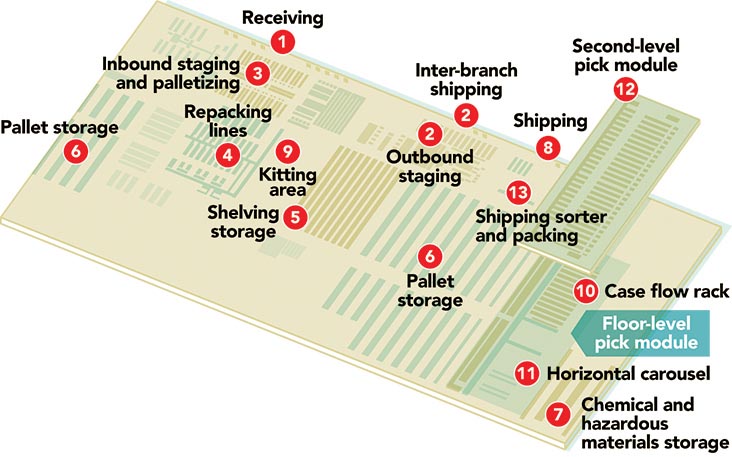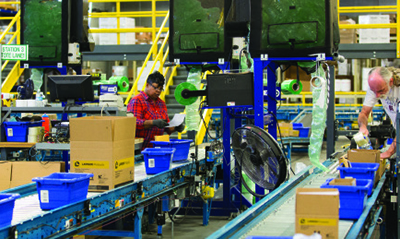Lawson Products: Automation that fits
Lawson Products’ new DC makes targeted use of automation to move MRO products through its extended supply chain.
Lawson Products built its new Chicago-area DC to service customers and to replenish its branch distribution centers. The facility not only fills orders, it also receives and repacks bulk items into customer-friendly quantities.
Lawson Products
McCook, Ill.
Size: 308,000 square feet
Products: Small parts and consumables for maintenance and repair
SKUs: 55,000
Throughput: 11,000 to 13,000 customer lines and up to 3,500 branch lines are shipped per day
Employees: 150 employees
Shifts per day/days per week: 5 days a week; 2.5 shifts per day
Receiving:
The facility receives (1) truckload, less-than-truckload (LTL) and parcel deliveries. All inventory is received into the enterprise resource planning (ERP) system against a purchase order (PO) created by the inventory management team. POs are created for the McCook facility or for one of the branch distribution centers. The ERP system then directs the next step in the process: Newly received merchandise might be crossdocked to an outbound staging area for inter-branch shipping, where they are forwarded to a branch DC; raw materials, or bulk items, will be sent to a quality control, inspection and palletizing area (3) and then to either a hand pack or an auto-bagging station (there are eight auto-baggers and 22 hand pack stations) (4); and finished goods will be directed to a shelving or pallet storage location (5,6). Chemicals and hazardous materials go to a special storage area (7). Once items are received into the ERP system, the PO is closed out.

Crossdocking:
High-volume products are pre-bagged or packed into bin boxes by suppliers prior to delivery. Those pallets are inspected and moved directly to an outbound staging area (2) in the shipping area (8), where they can be forwarded to the appropriate DC. Lawson has complete traceability on crossdock shipments from the time they arrive in McCook until they are received at a forward DC.
Raw materials:
Any SKU that is received in bulk quantities and repacked is considered a raw material. As an example, a box of 5000 cap screws may be rebagged into 200 bags of 25 screws each. The ERP system creates a work order that identifies how the product is supposed to be bagged and whether it can be processed at an auto-bagging station or, in the case of larger or bulkier items such as hammers, needs to be hand bagged. During the packaging process (4), the system captures the country of origin, the identification of the material and the receipt it arrived on. Once the inventory has been processed, the packages are placed in bin boxes for storage (5). The system notes any variances in the quantities ordered and received and sends that information back to the supplier. The newly bagged product is received as a finished good and is now available to promise.
Pre-packaged items:
High volume items are pre-packaged in order quantities by the supplier, but shipped in bulk boxes. The pre-packaged items are placed in bin boxes for uniform storage on shelves (5) or horizontal carousels (11) and for palletizing (3).
Kitting:
In a kitting area (9), DC associates build kits of multiple bags of finished goods for Vendor Managed Inventory. Those items are scanned into bin boxes and stored on shelving in an area designated for kitted items.
Putaway:
All other newly received product is putaway into pallet rack (6) based on the size of the product. Lift truck operators are directed by the ERP system to a storage location and scan the pallet into that location.
Picking:
While the ERP system receives orders, picking waves are created by a warehouse execution system (WES). Orders can be picked from the reserve storage area (5,6); case flow rack (10) in a two-level pick module; a horizontal carousel system (11); or, in the case of chemicals or hazardous materials, from restricted storage areas (7). Orders are received throughout the day and evening; at midnight, the system begins to create stock transfers for the branch DCs. Those are released to the floor at 7 a.m.; customer orders are released at 10 a.m. The WES creates waves so that any items outside of the pick modules are picked first.
Items picked outside of the pick module are scanned into cartons on a pick cart. An associate can pick multiple orders at a time. Once a batch is picked, the cartons are inducted onto the conveyor system and travel to the floor level of the pick module. Items are stored according to velocity. The fastest-moving items are picked from case flow rack (10) and scanned using wrist-mounted computers and ring scanners; mid-range items are picked at goods-to-person stations at the horizontal carousels (11), where associates are directed by lights. The slowest-moving items are stored on shelving on the second floor. (12) Every carton travels to the second floor, even if there are no items to be picked.
Packing:
Once the order is picked complete, it passes over a quality control scale that weighs the carton and checks for overages or shortages. When there is a variance outside of system tolerances, the carton is diverted to an inspection area. Otherwise, it is conveyed to a packing mezzanine. There, one of three actions can take place.
- Some orders will randomly be sent to a QC area for inspections. If they pass inspection, those cartons—along with cartons that were not inspected—are sorted (13) to one of four packing stations.
- At packing, the contents of the carton are re-confirmed, dunnage is added and the carton is sealed and automatically labeled.
- Or, a carton can be sorted to a value-added services line if it requires special labeling or packaging.
Shipping:
Once cartons have been inspected, packed and sealed, cartons are conveyed to the shipping area (8). Most will go directly into a UPS truck. The remainder will be diverted to an LTL line where they are married with other bulk items for that order, or to a third spur if the carton is part of a delivery to a branch DC.
System suppliers:
System Design & Integration: Peach State
Conveyor & Sortation: Hytrol
Enterprise Resource Planning (ERP): SAP
Warehouse Execution Software (WES): Numina Group
Horizontal Carousel: Sapient/ MDCI Automation
Lift Trucks: The Raymond Corporation
Bar Code Scanning/Wrist Scanning: Zebra Technologies (Motorola) Honeywell (LXE)
Cubing & Weighing: Cubiscan
Shipping Software: ADSI













